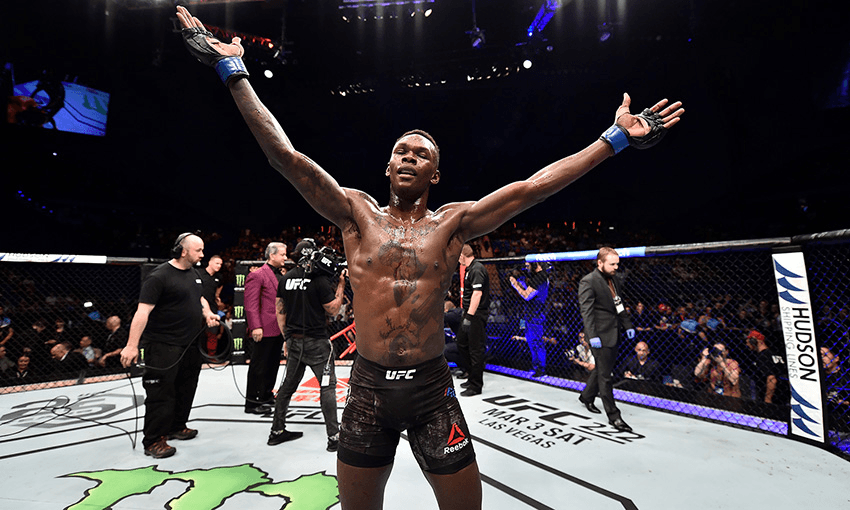After almost a decade of combat sports experience, New Zealand’s Israel Adesanya made a highly anticipated and violent entrance to the UFC on Sunday afternoon. Don Rowe reports.
When Australian wrestler Rob Wilkinson crumpled to the floor at Sunday’s UFC event in Perth, his nose plastered across his face and bleeding profusely from cuts around both eyes, it was the sort of scene that makes conservative politicians scream “human cockfight”. His opponent, Auckland’s Israel Adesanya, dished out the sort of beating that, outside the insane sport of mixed martial arts, would probably constitute some real jail time. But lost to many amongst the carnage was the fact that the debuting Adesanya had just demonstrated what happens when the best kickboxer on the planet finally gets a shot at the big leagues.
“I’m the new dog in town,” Adesanya announced, still covered in his opponent’s blood. “And I just pissed all over this cage.”
And with that, New Zealand’s latest superstar arrived on the world stage, claiming a $50,000 bonus check in the process.
1️⃣2️⃣ fights
1️⃣2️⃣ wins
1️⃣2️⃣ finishes@Stylebender finishes Wilkinson in round 2!! What a debut!! #UFC221 pic.twitter.com/wAt0tMyLKp— UFC (@ufc) February 11, 2018
A veteran of close to 100 fights across four different martial arts, Adesanya entered the UFC on a flawless undefeated streak, with all 11 of his MMA bouts ending by knockout within two rounds. Having fought in front of the biggest crowds in China and beyond, he was unfazed by the bright lights of the world’s premier MMA organisation, and after an eight year journey to the top, he left the cage with nary a scratch to be seen – aside from his swollen knuckles.
I’ve been following Adesanya since 2013. A phenomenal kickboxer – athletic, accurate, cerebral – it was clear to me that he had all the potential in the world to be a superstar on par with any in martial arts. He’s tall, he’s violent, he’s a male model, and, crucially, he has the personality to go with it; Adesanya is every bit as flamboyant as his striking style, mouthing off at a moment’s notice and dropping the sort of lines that would have most of New Zealand Twitter foaming at the mouth.
Read more: I Want to be Immortal: A Few Beers with Prizefighter Israel Adesanya
In fact, his trash talk and antics are precisely of a sort that would rub conservative old New Zealand the wrong way – outwardly an unapologetic arrogance, but in fact a carefully considered approach valuable both in a promotional sense, but also as a bulwark against the intense pressure inherent in a sport where death or disability is a very real possibility.
And, as Adesanya has reiterated over and again, this is the fight game, and there’s a strange double standard at work when fans of sanctioned brain trauma want fighters to watch their language. “People are like ‘think of the kids’, well, the kids just watched me put this dude in hospital, so…”
In media around the globe, comparisons are being made to the meteoric rise of another devastating striker: MMA’s richest and most famous athlete, Ireland’s Conor McGregor. The fighters share the same tendencies, both in their mannerisms and the state of the bodies they leave in their wake. They’re brash, confident and intensely violent. Similar, too, are their detractors. As Conor McGregor slashed through opponent after opponent in the UFC, pundits and armchair critics alike predicted problems against competent grapplers. Adesanya is facing identical claims today, while McGregor sits pretty as the first fighter to bend the union-busting, monopolistic UFC to his will. The blueprint to superstardom exists, and Adesanya has the skillset to make it happen.
Signed to a four-fight contract, Adesanya faces a tough climb to the top of the sport, with opposition much more dangerous than the middling Rob Wilkinson standing between him and a title shot. But once he gets there, as I believe he will, a showdown with the first Māori UFC champion, Australia-based Robert Whittaker, looms as the greatest trans-Tasman battle we’ve ever seen.
My advice is to get your hype tickets now, because the train is leaving the station and there are no brakes in sight.


